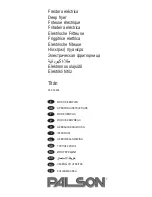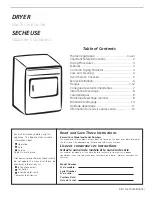
3-6
n
Whirlpool & Maytag 9.2 Cu. Ft. Steam Dryer
COMPONENT TESTING
For Service Technician Use Only
DANGER
Electrical Shock Hazard
Only authorized technicians should perform
diagnostic voltage measurements.
After performing voltage measurements,
disconnect power before servicing.
Failure to follow these instructions can result in
death or electrical shock.
Component Testing
TESTING DRYER COMPONENTS FROM THE
CONTROL
Before testing any of the components, perform the following
checks:
• The most common cause for mis-diagnosed control
failure is poor connections. Therefore, disconnecting,
inspecting and reconnecting wires will be necessary
throughout test procedures.
• All tests/checks should be made with a VOM or DVM
having a sensitivity of 20,000 ohms-per-volt DC, or
greater.
• Check all connections before replacing components,
looking for broken or loose wires, failed terminals, or
wires not pressed into connectors far enough.
• Voltage checks must be made with all connectors
attached to the boards.
•
IMPORTANT:
Resistance checks must be made with
power cord unplugged or power disconnected, and
with wiring harness or connectors disconnected from
the control.
The testing procedures in this section may require the use
of needle probes to measure voltage. Failure to use needle
probes will damage the connectors.
TEST #1: ACU Power Check
This test is used to determine if power is present at the
machine control electronics. This test assumes that proper
voltage is present at the outlet.
1. Verify that the green LED on the ACU is lit when the dryer
is turned on.
NOTE
: It is important to verify that the ACU is not in
“Hibernate” mode. If the user interface is working
correctly, it will “wake up” the ACU after powering up. To
verify, unplug dryer or disconnect power for 60 seconds.
Plug in dryer or reconnect power. Press POWER. If the
ACU comes up (i.e., the green LED in the center of the
ACU flashes and then stays lit after boot-up is complete),
there may be a problem with the user interface.
2. Unplug dryer or disconnect power.
3. Check for appropriate line voltages at the outlet: 240 VAC
(electric 2-phase), 208 VAC (electric 3-phase), or 120 VAC
(gas).
¾
If line voltage is present, go to step 4.
¾
If line voltage is not present, check for tripped circuit
breaker or blown household fuse. If CB (circuit breaker)
is not tripped, have customer check with qualified
electrician.
4. Remove console to access the machine electronics.
5. ACU VAC – With voltmeter set to AC, connect black probe
to ACU J8-3 (N) and red probe to J9-2 (L1). (See Figure 1,
page 3-7.) Plug in dryer or reconnect power.
¾
If 120 VAC is present, unplug dryer or disconnect
power and go to step 6.
¾
If 120 VAC is not present, unplug dryer or disconnect
power and perform TEST #2: Supply Connections, page
3-8.
6. ACU +5 VDC – With voltmeter set to DC, unplug connector
J2 from the ACU and connect black probe to ACU J2-3
(ground) and red probe to J2-1 (+5 VDC). Plug in dryer or
reconnect power.
¾
If +5 VDC is present, go to step 9.
¾
If +5 VDC is not present, go to step 7.
7. Unplug dryer or disconnect power. Unplug J14 from the
ACU. Plug in dryer or reconnect power and repeat step 6.
¾
If +5 VDC returns, one of the thermistors has shorted.
To diagnose thermistors, see TEST #4a, page 3-14.
¾
If +5 VDC is not present, go to step 8.
8. Unplug dryer or disconnect power. Reconnect J14 to
the ACU and unplug J2 from the ACU. Plug in dryer or
reconnect power and repeat step 6. Perform voltage
check inside header J2 on ACU, between pins 1 & 3—DO
NOT SHORT PINS TOGETHER.
¾
If +5 VDC is still missing, unplug dryer or disconnect
power and replace the ACU.
¾
If +5 VDC returns, unplug dryer or disconnect power
and check harnesses and connections between the ACU
and user interface (UI). If acceptable, replace the UI.
9. Unplug dryer or disconnect power.
10. Reassemble all parts and panels.
11. Perform steps under “Service Test Mode”, page 2-5, to
verify repair.
Continue to next page for ACU board diagram
and ACU connectors & pinouts
















































